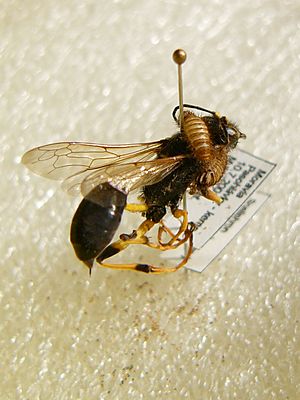Pest (biology) facts for kids
A pest is an animal or plant that causes harm to humans or things we care about. This can include our food, homes, health, or even our pets. Pests are often seen as competitors because they try to use resources that humans also need.
Contents
What is a Pest?
The word "pest" is used for many different living things. It often means creatures like insects, mites, or rodents that damage crops, spread diseases, or destroy property. It can also include plants we call weeds, which grow where they are not wanted and compete with useful plants.
Why Are Pests a Problem?
Pests can cause big problems for people around the world. They can:
- Destroy food: Many pests eat or damage crops in fields or stored food. This can lead to less food for people and animals.
- Spread diseases: Some pests, like mosquitoes or ticks, can carry germs that make humans or animals sick.
- Damage property: Pests like termites can chew through wood in houses, causing serious damage. Others might ruin clothes or furniture.
- Harm the environment: Invasive pests can harm local plants and animals, changing ecosystems.
Pests That Harm Plants
Many pests cause trouble for farmers by attacking important crops. Here are a few examples:
- Desert Locusts: These insects (Schistocerca gregaria) are famous for forming huge swarms. When millions of locusts fly together, they can eat all the crops in an area very quickly. This leaves nothing for people or livestock.
- Potato Blight: This is caused by a tiny organism called Phytophthora infestans. It's not a fungus, but an oomycete, which is like a water mold. It causes potatoes and tomatoes to rot, turning them black and mushy. This pest caused the terrible Irish Potato Famine in the 1840s.
- Colorado Beetle: The Colorado potato beetle (Leptinotarsa decemlineata) is a small, striped beetle. Both the adult beetles and their larvae love to eat potato leaves. If there are too many, they can completely strip a potato plant, stopping it from growing potatoes.
- Khapra Beetle: This tiny beetle (Trogoderma granarium) is a big problem for stored grains and seeds. It can quickly infest warehouses and silos, ruining large amounts of food that is meant to be eaten later.
- Wheat Stem Rust: This is a disease caused by a fungus (Puccinia graminis tritici). It attacks wheat plants, causing rust-colored spots on the stems and leaves. This makes the wheat plant weak and produces much less grain.
Pests That Harm Trees
Some beetles are serious pests of trees, especially in forests.
- Mountain Pine Beetle: The mountain pine beetle (Dendroctonus ponderosae) attacks pine trees. These tiny beetles bore into the tree's bark and lay their eggs. They also carry a fungus that helps kill the tree. Large outbreaks can destroy huge areas of forest.
- Emerald Ash Borer: This shiny green beetle is an invasive pest in North America. Its larvae tunnel under the bark of ash trees, cutting off the tree's ability to move water and nutrients. This usually kills the ash tree within a few years.
- Boll Weevil: The boll weevil (Anthonomus grandis) is a beetle that attacks cotton plants. It lays its eggs inside the cotton bolls (the part that produces cotton fibers). The larvae then eat the cotton, destroying the crop.
How Are Pests Controlled?
People use different methods to control pests. These can include:
- Biological control: Using natural enemies, like other insects, to control pests.
- Chemical control: Using special sprays called pesticides to kill pests.
- Cultural control: Changing farming practices, like rotating crops, to make it harder for pests to thrive.
- Physical control: Using traps, barriers, or even hand-picking pests.
Scientists are always looking for new and safer ways to manage pests, so we can protect our food, homes, and health.


